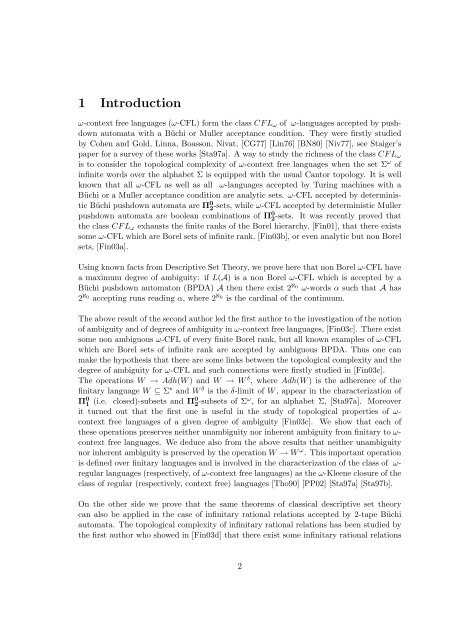Topology and ambiguity in ω-context free languages - HAL
Topology and ambiguity in ω-context free languages - HAL
Topology and ambiguity in ω-context free languages - HAL
Create successful ePaper yourself
Turn your PDF publications into a flip-book with our unique Google optimized e-Paper software.
1 Introduction<br />
<strong>ω</strong>-<strong>context</strong> <strong>free</strong> <strong>languages</strong> (<strong>ω</strong>-CFL) form the class CFL <strong>ω</strong> of <strong>ω</strong>-<strong>languages</strong> accepted by pushdown<br />
automata with a Büchi or Muller acceptance condition. They were firstly studied<br />
by Cohen <strong>and</strong> Gold, L<strong>in</strong>na, Boasson, Nivat, [CG77] [L<strong>in</strong>76] [BN80] [Niv77], see Staiger’s<br />
paper for a survey of these works [Sta97a]. A way to study the richness of the class CFL <strong>ω</strong><br />
is to consider the topological complexity of <strong>ω</strong>-<strong>context</strong> <strong>free</strong> <strong>languages</strong> when the set Σ <strong>ω</strong> of<br />
<strong>in</strong>f<strong>in</strong>ite words over the alphabet Σ is equipped with the usual Cantor topology. It is well<br />
known that all <strong>ω</strong>-CFL as well as all <strong>ω</strong>-<strong>languages</strong> accepted by Tur<strong>in</strong>g mach<strong>in</strong>es with a<br />
Büchi or a Muller acceptance condition are analytic sets. <strong>ω</strong>-CFL accepted by determ<strong>in</strong>istic<br />
Büchi pushdown automata are Π 0 2-sets, while <strong>ω</strong>-CFL accepted by determ<strong>in</strong>istic Muller<br />
pushdown automata are boolean comb<strong>in</strong>ations of Π 0 2-sets. It was recently proved that<br />
the class CFL <strong>ω</strong> exhausts the f<strong>in</strong>ite ranks of the Borel hierarchy, [F<strong>in</strong>01], that there exists<br />
some <strong>ω</strong>-CFL which are Borel sets of <strong>in</strong>f<strong>in</strong>ite rank, [F<strong>in</strong>03b], or even analytic but non Borel<br />
sets, [F<strong>in</strong>03a].<br />
Us<strong>in</strong>g known facts from Descriptive Set Theory, we prove here that non Borel <strong>ω</strong>-CFL have<br />
a maximum degree of <strong>ambiguity</strong>: if L(A) is a non Borel <strong>ω</strong>-CFL which is accepted by a<br />
Büchi pushdown automaton (BPDA) A then there exist 2 ℵ 0<br />
<strong>ω</strong>-words α such that A has<br />
2 ℵ 0<br />
accept<strong>in</strong>g runs read<strong>in</strong>g α, where 2 ℵ 0<br />
is the card<strong>in</strong>al of the cont<strong>in</strong>uum.<br />
The above result of the second author led the first author to the <strong>in</strong>vestigation of the notion<br />
of <strong>ambiguity</strong> <strong>and</strong> of degrees of <strong>ambiguity</strong> <strong>in</strong> <strong>ω</strong>-<strong>context</strong> <strong>free</strong> <strong>languages</strong>, [F<strong>in</strong>03c]. There exist<br />
some non ambiguous <strong>ω</strong>-CFL of every f<strong>in</strong>ite Borel rank, but all known examples of <strong>ω</strong>-CFL<br />
which are Borel sets of <strong>in</strong>f<strong>in</strong>ite rank are accepted by ambiguous BPDA. Thus one can<br />
make the hypothesis that there are some l<strong>in</strong>ks between the topological complexity <strong>and</strong> the<br />
degree of <strong>ambiguity</strong> for <strong>ω</strong>-CFL <strong>and</strong> such connections were firstly studied <strong>in</strong> [F<strong>in</strong>03c].<br />
The operations W → Adh(W) <strong>and</strong> W → W δ , where Adh(W) is the adherence of the<br />
f<strong>in</strong>itary language W ⊆ Σ ⋆ <strong>and</strong> W δ is the δ-limit of W, appear <strong>in</strong> the characterization of<br />
Π 0 1 (i.e. closed)-subsets <strong>and</strong> Π0 2 -subsets of Σ<strong>ω</strong> , for an alphabet Σ, [Sta97a]. Moreover<br />
it turned out that the first one is useful <strong>in</strong> the study of topological properties of <strong>ω</strong>-<br />
<strong>context</strong> <strong>free</strong> <strong>languages</strong> of a given degree of <strong>ambiguity</strong> [F<strong>in</strong>03c]. We show that each of<br />
these operations preserves neither un<strong>ambiguity</strong> nor <strong>in</strong>herent <strong>ambiguity</strong> from f<strong>in</strong>itary to <strong>ω</strong>-<br />
<strong>context</strong> <strong>free</strong> <strong>languages</strong>. We deduce also from the above results that neither un<strong>ambiguity</strong><br />
nor <strong>in</strong>herent <strong>ambiguity</strong> is preserved by the operation W → W <strong>ω</strong> . This important operation<br />
is def<strong>in</strong>ed over f<strong>in</strong>itary <strong>languages</strong> <strong>and</strong> is <strong>in</strong>volved <strong>in</strong> the characterization of the class of <strong>ω</strong>-<br />
regular <strong>languages</strong> (respectively, of <strong>ω</strong>-<strong>context</strong> <strong>free</strong> <strong>languages</strong>) as the <strong>ω</strong>-Kleene closure of the<br />
class of regular (respectively, <strong>context</strong> <strong>free</strong>) <strong>languages</strong> [Tho90] [PP02] [Sta97a] [Sta97b].<br />
On the other side we prove that the same theorems of classical descriptive set theory<br />
can also be applied <strong>in</strong> the case of <strong>in</strong>f<strong>in</strong>itary rational relations accepted by 2-tape Büchi<br />
automata. The topological complexity of <strong>in</strong>f<strong>in</strong>itary rational relations has been studied by<br />
the first author who showed <strong>in</strong> [F<strong>in</strong>03d] that there exist some <strong>in</strong>f<strong>in</strong>itary rational relations<br />
2
















